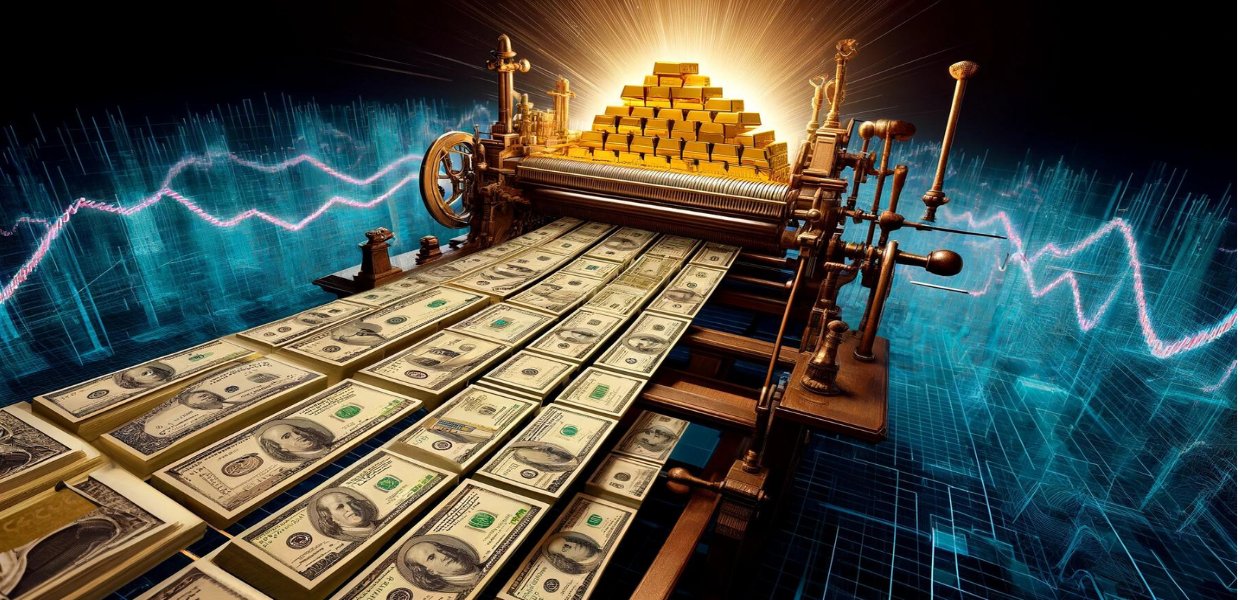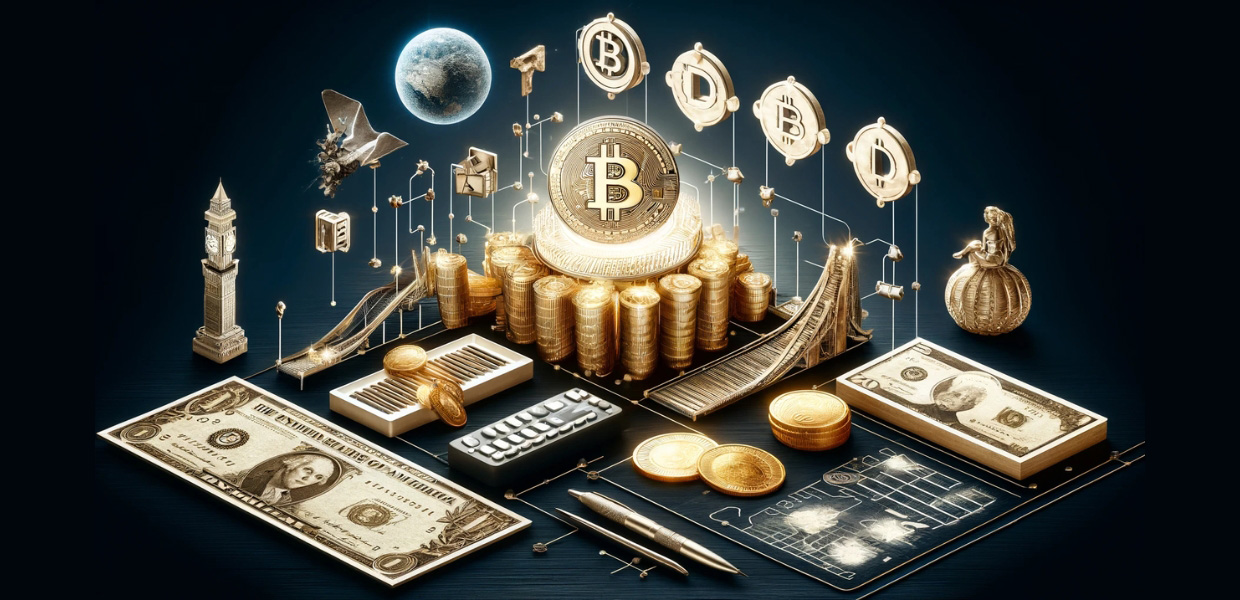We frequently hear people commenting, “Isn’t it crazy how high the price of gold is?” or “The price of gold hit a new high today.” We think it’s high time we analyze this thought process a bit. For starters, gold is primarily quoted in US dollars globally, which means the US dollar is the measure against which the price of gold is going up. We suggest there is another means to look at the equation, and one that is a lot more accurate and explainable than the “price of gold is going up.”
It has to do with the dollar going down, or more accurately spoken, the faith and confidence in the dollar is evaporating for several reasons. What’s rising is the purchasing power of a precious commodity of intrinsic value and monetary utility—gold, versus a fiat money instrument that has zero intrinsic value and is being inflated into the stratosphere, along with the devaluation of its purchasing power.
The dollar, like all fiat currencies, derives its value solely from public faith in its worth as a monetary instrument. To illustrate this concept more vividly, let’s compare the dollar to gold, which is often lauded for its intrinsic value.
Consider owning 1 ounce of gold. Its value, while expressed in fiat currency, is inherently tied to its physical weight—a tangible measure. Now, if you possess 100 ounces of gold, its intrinsic value is not subjectively determined but is exactly 100 times that of the 1 ounce. This value is consistently measurable against any fiat currency at any given time, demonstrating a linear and predictable relationship. This consistency arises because gold’s worth is anchored in its physical properties; each ounce maintains its value proportionally.
Now let’s take a closer look at a one-dollar bill. Essentially, it’s just a piece of paper splattered with ink. Its market value? One dollar. Now, consider a US $100 bill. This bill, too, is crafted from a piece of paper of the exact same size. It incurs no additional production costs. So, perhaps it uses gold leaf or something else luxurious to justify its heftier valuation over its one-dollar sibling, right? Wrong. It’s adorned with the same ink, the same hues. Essentially, the intrinsic value of both notes is merely the cost of the paper and the predominantly green ink used. Could it be the portraits of different presidents that add the extra zeroes? Is Benjamin Franklin really 100 times more esteemed than George Washington? Surely, that must be the explanation, no?
The two bills—whether one or one hundred dollars—carry different values solely because the public believes they do. Strip away that faith, and what are you left with? Just pieces of paper. The phrase “In God We Trust” now adorns these bills, a stark contrast to the older assurance that once graced them, stating, “This certifies that there have been deposited in the Treasury of the United States of America [X number of] dollars in gold coin payable to the bearer on demand.” This shift from a tangible backing in gold to a reliance on collective belief highlights just how much our currency system is built on faith and nothing else.
Today, in the age of the Internet Reformation, we have a similar experience happening as that which occurred shortly after the invention of the Gutenberg press, developed around 1440 in Mainz, Germany. This invention played a pivotal role in the spread of knowledge, making books more accessible and affordable.
Shortly thereafter, the Protestant Reformation started in 1517 when Martin Luther nailed his Ninety-Five Theses to the door of the All Saints’ Church in Wittenberg, Germany. This act is traditionally regarded as the catalyst for the Reformation, a period of significant religious change that led to the establishment of Protestant churches separate from the Roman Catholic Church.
The Gutenberg press was the catalyst that initiated the Protestant Reformation. Prior to its invention, the Catholic Church literally controlled the media; they were the media. There was no means to read the Bible for oneself and debate the literal word and the meaning behind the scriptures. In other words, communication was a one-way trip from the Vatican on down, in cahoots with the regional monarchies, of course.
However, with the invention of the Gutenberg press, all that changed. People started to gather in groups and interpret the scripture for themselves, and they began to challenge the messages being emitted from Rome until the eventual widespread reformation began, generally attributed to Mr. Luther.
Roughly 500 years later, enter stage left, the Internet. The first uncontrolled communications medium to come along since the Gutenberg press. And just like the press before it, the Internet medium is causing untold numbers of millions of people worldwide to question much of our societal edifices, such as the global banking system, based on fiat currency and controlled by central banks.
The media structures of control erected by elite interests prior to the arrival of the Internet have been losing their reach and influence at an ever-increasing rate. Why? Because people can see the statist agenda inherently aligned with mainstream media interests—practically every aspect of media was under the control of system-supporting interests. One never heard anyone in those mediums challenging the honor and integrity of the US dollar, or fiat currencies generally.
But now, oh yes you certainly do, and at a pace much faster than that which occurred between the arrival of the Gutenberg press and the eventual Reformation against the Catholic Church’s control.
Today, people are losing faith in the value of fiat currencies and the global debt-based system that rewards bankers with interest on money effectively created out of nothing and based on pure faith. People can see the one-sidedness of the system and the serious credibility faults it inherently possesses. And the Internet Reformation has found a massive following of support reflected in the prominent rise of DeFi currencies such as Bitcoin and the rest of the cryptocurrency gathering. The passion is strong for their supporters and it is fully understandable and to be admired in our opinion. Even if we disagree with the ultimate solution being offered.
The problem is twofold for Bitcoin, for example, it too has no intrinsic value. It is also inelastic with respect to its supply and thus unable to increase its supply to offset sharp rises in demand, thus making its price very unstable and instability is the archenemy of a monetary unit.
To be a monetary unit of value, the candidate must have a relatively stable price that inspires confidence to use it as a store of wealth. Without that fundamental characteristic, a unit cannot satisfy the role of money. Therefore, Bitcoin and cryptocurrencies simply put lack the intrinsic value and the supply elasticity to support a currency.
That brings us to NatGold™, a new crypto commodity that’s 100% backed by gold resources certified under National Instrument 43-101 (NI 43-101). These NI 43-101 Technical Reports are considered the gold standard globally for assessing the probability of economically extracting gold resources and reserves. They are a crucial tool for mining financiers making decisions about whether to proceed with mine construction. In essence, there is no higher benchmark in the industry.
NatGold is backed by the solid in-ground value of rigorously certified gold, mined digitally in a manner that’s completely ESG-friendly. The amount of certified gold available for tokenization far surpasses the volume of physical gold being extracted, reflecting the diminishing global availability of mining permits. The harsh environmental and social impacts of traditional gold mining are becoming increasingly unacceptable in our ESG-aware era, and this shift in values is here to stay. NatGold’s extensive supply pipeline and its swift digital mining process tackle a key criticism of physical gold: its supply, dependent on physical extraction, has been too rigid to adapt to economic shifts.
NatGold embodies all the virtues of gold, minus the environmental toll. It frees the world’s verifiable gold resources to bolster a new crypto commodity currency, reinvigorating gold’s ancient role as a dependable repository of monetary wealth, now with an ESG-friendly twist.
We believe it’s time for the Internet Reformation to truly ignite, and for the enthusiasm around Bitcoin and other cryptocurrencies to discover NatGold. Change is swirling around us—will the winds favor the direction of NatGold? We’re inclined to believe they will.
Enjoyed this article? Subscribe to NatGold News & Insights for the latest staff updates, expert analysis, exclusive interviews, and updates whenever NatGold is making headlines — all delivered straight to your inbox!
Share This Story!
More Staff Insights
Cryptocurrencies, especially Bitcoin, have ignited...
The term "ESG" gained prominence with the 2004 rep...
Gold mining, while a lucrative and age-old industr...





